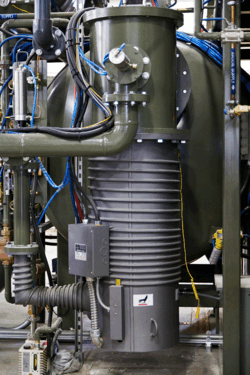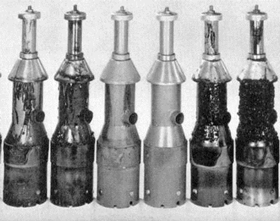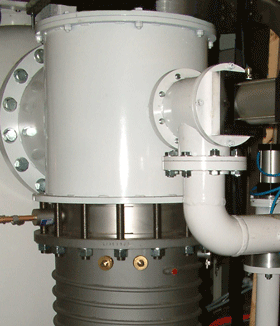You have no items in your shopping cart
Maintaining Oil Diffusion Pumps
- Posted on
- Posted in Maintenance Guides, Vacuum Pump
- 0

Even as turbomolecular vacuum pumps have displaced most small laboratory sized oil diffusion pumps these days because of perceived ease of use and cleanliness, most high vacuum heat treating furnaces still rely on a large oil diffusion pumps to generate the pressures below about 10-3 Torr needed for many metal conditioning processes.
The main reason for this is that turbomolecular vacuum pumps have a physical size limit due to the high rotational speed of the rotor. That size limit is around 320 mm or 13 inches inlet diameter and may vary a small amount from manufacturer to manufacturer. In many cases the pumping speed may not be high enough as it is directly related to the inlet size of the pump. Metal can disintegrate at very high speed, so the tip speed of the rotor blades has to be within the safe limit. Turbomolecular pump rotors have to move faster than the speed of the gas molecules they are pumping in order that the rotor blades can deflect the gas molecules downwards in the pump mechanism. The second reason that turbomolecular pumps are not used in many metal treating systems is they cannot tolerate any particulate matter entering them. They must only be used on clean vacuum systems.
Due to the fact that there are no moving parts in the oil diffusion pump (Fig. 1) itself (apart from the oil whether as liquid or vapor) this type of pump is a simple device that has proved its value over many years. The original fluid used in diffusion pumps was mercury but it was banned once its toxicity was realized. (Mercury vacuum gauges were taken off the market for the same reason) Hydrocarbon oils were developed for use in diffusion pumps but this fluid was found to very susceptible to oxidation if exposed to air at too high a pressure. The 21% or so of oxygen in the air causes the hot oil vapor to turn to a tarry deposit which contaminates the jet assembly inside the diffusion pump body and makes the pump performance unstable.
The most frequently used diffusion pump fluid used in the heat treating industry for the last thirty or more years is silicone oil. It is available in three main grades, usually designated at 702, 704 and 705. Silicone oil is more resistant to oxidation than hydrocarbon based fluids. These were grades of silicone oil developed by Dow Corning that are now also available from other suppliers. The vacuum that can be produced using these grades of fluid increases from 702 to 704 and to 705. Silicone 702 and 704 may be the main grades used in this industry, with 705 being used more in higher vacuum applications (lower pressure) in research due to its higher cost.
My personal suggestion is to purchase this product from a reputable distributor who will warranty its quality and performance. Cheapest is not always best. This discussion is about keeping your oil diffusion pumps operating in top condition.
Areas of concern about oil diffusion pump operation and maintenance:
Cleanliness of the whole system
One of the main comments that I have made to vacuum system operators over the years is the cleanliness of their system. Vacuum chambers, vacuum pumps and all the associated piping, valves gauges and controls will work more efficiently if they are clean. That means removing dust and dirt from all surfaces and looking for problem areas where maintenance may be required. If the chamber, piping and vacuum equipment has oil and dust on its surfaces it will not give off heat as efficiently as it will if it is clean.
Fluid oxidation and contamination
 |
| Fig. 2. Oxidation of oil on jet assemblies |
A diffusion pump works by boiling the fluid and then directing the hot oil vapor outwards and downwards through cone shaped jets at a very high speed. Molecules of gas entering the top of the pump are entrained in this vapor stream and redirected to the lower areas of the pump body. When the hot vapor contacts the water cooled pump body it returns to liquid and drains back to the boiler to recirculate again. The gas molecules, when they reach the lower part of the pump body, having undergone a compression through each jet stage, are pumped away through the exhaust port of the diffusion pump to the mechanical backing pump. There is a baffle arrangement in the exhaust area of the pump to condense any remaining oil vapor, so that it remains inside the diffusion pump.
When the high vacuum valve is initially opened to start the high vacuum part of the cycle, the gas load that the diffusion pump has to pump away is at its highest, and therefore has the largest amount of oxygen molecules in it. At this time some fluid may become oxidized and it will start to form a residue on the interior surfaces of the pump. (Fig. 2) In Fig. 2 the two middle jet assemblies from pumps using silicone fluid are compared the other four jet assemblies used with hydrocarbon fluid.
If the vacuum system is switched to high vacuum pumping at too high a pressure two things may happen.
1. More fluid will become oxidized and eventually the pump performance will degrade due to the buildup of burnt oil and the pump will have to be cleaned;
2. It is possible to stall the vapor jets of the pump due to a high back pressure in the bottom of the pump and the backing line.
If too much gas is allowed into the pump during the crossover from roughing to fine pumping the backing mechanical pump can’t pump it away fast enough to keep the backing line pressure below the critical backing pressure (CBP) for that pump. Every oil diffusion pump specification states the CBP for the fluid being used in it. (Fig. 3) The backing line pressure must stay below that pressure to prevent the vapor jets from stalling. If the vapor jets stall, even for a second or two, hot oil vapor can easily move back towards the vacuum chamber and cause contamination.
It is important at the high vacuum crossover point to open the high vacuum valve slowly for the first few seconds. This reduces the initial very high gas loading of the diffusion pump and allows that gas to be pumped away by the mechanical backing pump without the backing line pressure exceeding the CBP. The backing line pressure can be monitored by a vacuum gauge head and a set point in the control system can close the high vacuum valve if the backing line pressure approaches the CBP. Opening the pneumatically operated high vacuum valve slowly can be achieved by throttling the air outlet of the pneumatic cylinder. (Fig. 4) The pneumatic cylinder, located on the top of the high vacuum valve elbow, is actuated by compressed air by an electrically operated solenoid valve. An adjustable exhaust muffler is installed on the air outlet from the opening circuit of this valve and it is set to give the required slow opening time needed to prevent overloading and stalling of the diffusion pump during the crossover process. The closing of the high vacuum valve does not need to be regulated.
Note that during the chamber roughing part of the cycle the main mechanical pump or pump set is isolated from the diffusion pump backing line. A small mechanical “holding pump” connected into the backing line evacuates any outgassing from the diffusion pump during the roughing process to keep the backing line pressure well below the CBP.
Vacuum seals and Air leaks
All metal treating vacuum furnaces have many chamber, piping and pump set connections that all need to be leak tight. Large connections such as the chamber door and high vacuum valve elbow assembly usually use o-ring seals to make them leaktight. The chamber door seal is prone to damage near the bottom of the chamber where debris may stick to it and damage the seal when the door is closed. That area should always be cleaned just prior to the chamber door being closed. These are also close to the hot chamber and hot diffusion pump and may deteriorate due to the heat. Prolonged exposure to heat will harden the elastomer and it may become brittle and crack.
 |
| Fig. 3. Critical Backing Pressure (CBP) |
The o-ring seal in the high vacuum valve plate is an internal seal, sealing the chamber from the inlet of the diffusion pump, but it must also be leak tight. If air leaks across the seal into the diffusion pump when the chamber is at atmospheric pressure the oxygen in air may cause oxidation of the hot pump fluid.
Threaded vacuum connections are difficult to make leak tight and should be avoided. This is easier these days with the o-ring sealed ISO and NW vacuum connections that are available in standard sizes.
In chambers that are heated and cooled on a regular basis it is possible for a weld to develop a crack and leak. Leak testing with a helium mass spectrometer will allow small leaks to be pinpointed and then fixed.
Heater failure
Most large oil diffusion pumps use flat donut shaped heaters or platen style heaters to boil the oil in the pump. There may be two or perhaps up to eight heaters needed to do this job. Most heaters are mounted on the underside of the boiler plate, but I have seen one diffusion pump design where the heaters were inside the pump body immersed in the fluid. One or more heaters failing will quickly show up as a loss of base vacuum and or vacuum level instability. Due to the hot area even connecting wires will sometimes fail and wiring connectors should always be checked for tightness. These should be checked when regular maintenance is carried out and replaced as needed.
When fitting new heaters always make sure that the base of the boiler plate is clean and free of scale. Scale flakes trapped between a heater and the boiler plate will cause a hot spot and possibly premature heater failure. It is also possible for a boiler plate to warp over years of service. One of the heater suppliers has a heater contact paste that may help improve contact between a heater and the boiler plate.
Water flow problems
The diffusion pump has a recommended rate of flow and should be adjustable. Depending on location and local conditions the water flow can be adjusted to give the recommended rise in temperature from inlet to drain. The cooling coils should be examined for damage regularly and the inside checked for any buildup of lime deposits.
Many plants use treated water from their own recirculating water supply which will reduce or eliminate this problem, but it can be a problem if city water is used.
Safety when removing and replacing a diffusion pump from the chamber system
Diffusion pumps are large and heavy. Use all safety devices and support equipment when removing or remounting one to the high vacuum elbow assembly. Ensure that the inlet flange seal is correctly installed to prevent a leak. When draining the fluid from a large diffusion pump, warming it by switching on the heaters for three or four minutes will make it flow easier through the small drain connection. Always replace any o-ring seals in the oil drain or oil level indicator area as they will have been compromised due to the heat. When charging a diffusion pump with fresh fluid it can be poured in either the inlet or exhaust connections. The oil will find its way to the boiler. Lastly, never open the drain valve when the pump is in operation. Oxygen and the hot oil do not go well together!
 |
| Fig. 4. High vacuum valve elbow |
Safety devices that are part of the controls
All metal treating vacuum systems incorporate a number of safety devices into the control system. These should all be checked for correct operation on a regular basis.
On the diffusion pump there may be a water flow temperature switch mounted on the water coils. If the water temperature gets too hot the switch will shut off power to the pump. There may also be a pump ready switch mounted near the exhaust connection that indicates on the control panel that hot oil vapor is reaching that area and the pump is operating correctly.
Power problems
If the power fails for any reason the system should be designed to fail safe. Valves will close to isolate the pumps from the chamber to prevent possible damage. Electric solenoid valves should be normally closed (no power).
Pneumatic problems
Compressed air is generally used to operate cylinders such as on the high vacuum valve when the movement of the device is more than about a half inch. Electric solenoid valves are generally limited to a 50 mm (2 inch) diameter. Above 50 mm most valves will be pneumatically operated. Again, valves operated by compressed air should fail safe if the air pressure fails.
Conclusions
There are many parts to a vacuum system and for those that require high vacuum the diffusion pump is the pump that creates that pressure from perhaps 10-3 to around 10-8 Torr depending on the process.
Regular cleaning, checks and maintenance should be second nature. It is similar to washing your own car. That’s when you see a small dent, scratch or worn tire tread that you hadn’t noticed before.
Although they are simple pumps there many things that can go wrong, and maintaining them correctly and safely will allow them to last for many years. I am interested in any suggestions, personal experiences you have or omissions that you find when reading this article as it will add to everyone’s knowledge.
Copyright Howard Tring, Tring Enterprises LLC Vacuum & Low-Pressure Consulting.


Comments
Be the first to comment...